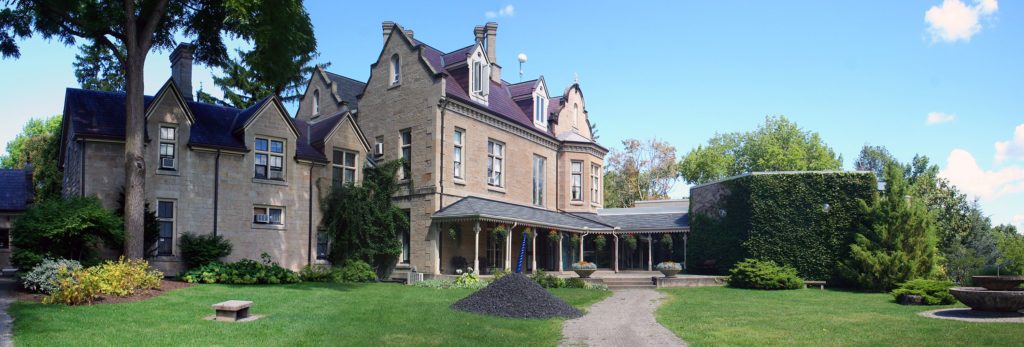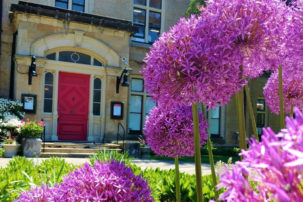Many in the Niagara arts community have been voicing increasing concern this past week about Brock University’s new plans for Rodman Hall, announced April 2.
“I’m quite appalled,” says Debra Attenborough, who worked in education programs at Rodman Hall in the 1980s and 1990s and is now executive director of the Niagara Falls Art Gallery. “There doesn’t seem to be a lot of listening at the university level to the community.”
Attenborough notes that Rodman Hall has functioned as an art gallery for nearly 60 years, with a collection encompassing the likes of Henry Moore, Henri Matisse, Emily Carr, the Group of Seven, and Painters Eleven. In the 1980s and 90s, the Class A gallery hosted exhibitions on the Surrealists and other key movements.
Brock University’s new plans for Rodman Hall would see its collection moved to a suitable storage unit in the university’s School of Fine and Performing Arts, and its heritage building and grounds managed by a private company with only the “potential to include a dedicated art gallery space.” The university also promises 2,000 square feet of new gallery space in the School of Fine and Performing Arts building, and a new 7,000-square-foot creative hub downtown, but hasn’t yet detailed how that will happen or be funded.
“We believe Brock has underestimated the complexities, costs and risks of moving the public art museum function and collection to the [School of Fine Art],” says Rodman Hall Alliance member Rebecca Cann. “The end result will be the loss of the only professional art museum in St. Catharines, one of only two in Niagara.”
“We believe Brock has underestimated the complexities, costs and risks of moving the public art museum function and collection,” says Rebecca Cann.
City Councillor on Culture Calls for New Report
“I’ve had many calls from people in the arts community who are concerned about these plans,” says City Councillor and St. Catharines cultural sustainability chair Carlos Garcia, who has just commissioned a staff report on the status and future of Rodman Hall.
The report will be presented at Council next week, where community members will have an opportunity to voice their concerns.
In recent years, Councillor Garcia was one of the forces to push for heritage designation of Rodman Hall to protect its architecture and grounds from future development. That effort succeeded in 2018, but there’s still the collection to consider. The councillor questions the feasibility of housing Rodman Hall’s collection in the School of Fine and Performing Arts building in terms of space and environment:
“[Brock University] claims that they are very conscious about the collection and the building, so I’m taking them at their word,” says Garcia. “But I want to make sure that they are both protected.”
Brock is already in “exploratory discussions with a company that envisions a commercially viable redevelopment,” says the university.
Wheels in Motion, Savings Deadline Set for May 1
The university says it has to make these changes, or find similar savings, by May 1 due to financial pressures—namely to make up for a projected $15 million shortfall in 2019 due to the Ontario government’s announcement of university funding cuts in January. The university contends it spends $750,000 annually on Rodman Hall operations and that the hall will need capital expenditures of $1 million a year in future.
And wheels for the new plan are already in motion. Last month, the university’s board of trustees approved the transfer of Rodman Hall’s art collection to a “community transition group” to explore different ways to maintain the collection and display it across Niagara. According to Brock News, “exploratory discussions with a company that envisions a commercially viable redevelopment, while strictly preserving the character and history of the facility” are already happening.
And while Brock doesn’t yet know where exactly to locate 2,000 square feet of art storage in its School of Fine and Performing Arts building, a recent letter from Greg Finn, Interim Provost, indicates that representatives “[have] been working with Facilities Management and [consultant] Cindy Goldrick to address concerns” around space for storage.
“Brock’s new plans do not fulfill the covenants of the 2003 agreement between the community and Brock University” to keep the space used as an art centre, says Sandy Middleton.
Are Brock’s New Plans a Breach of Contract?
The Rodman Hall Alliance, a community group that champions the continuation of the gallery, is speaking up to highlight that Brock University’s plans may constitute a breach of contract.
“Brock’s new plans do not fulfill the covenants of the 2003 agreement between the community and Brock University,” says Sandy Middleton of the Rodman Hall Alliance.
The contract signed by Brock University, in effect until 2023, states that it will “dedicate a substantial portion of the buildings … to the non-exclusive use of an art gallery open to the public at certain designated times and dedicated to the showing and exhibition of the arts including the Permanent Art Collection.”
This would seem to contravene the new plan that does not guarantee an art gallery space in the Rodman Hall building.
The contract also indicates that the university “will not use the Lands and Buildings for any commercial purpose which is not related to general university uses or purposes.” It’s unclear how this latter requirement would dovetail with the signing over of Rodman Hall management to a private company.
Some community members felt that there were more tacit understandings to Brock’s commitment to keep Rodman Hall an active art centre.
Former city councillor Mark Elliott describes the university’s positive partnership with the city in developing a cultural hub within the downtown core, through the School of Fine and Performing Arts and FirstOntario Performing Arts Centre: “But part of the context of that partnership,” to Elliott’s mind, “was an understanding that Rodman Hall would still be there as part of that creative cluster.”
“The community has worked hard with the university to come up with an alternative plan for the gallery…[yet] there was not further consultation or discussion” on the new plan, says Mark Elliott.
A “Blindside” and a Communications Breakdown
As a young child growing up in St. Catharines, Mark Elliott regularly went to see exhibitions at Rodman Hall. He even exhibited there in student exhibitions, and says it was part of what made him want to go to art school, and later, as a city councillor, advocate for arts and culture in his home city.
To Elliott, the suddenness and unilateralness of Brock’s recent announcement is what caused such community outcry this week. “I think a difficult part for everybody is they have been really blindsided by this. The community has worked hard with the university to come up with an alternative plan for the gallery—and I think whether or not the university had decided they don’t want to go with that plan, there was not further consultation or discussion.”
Sandy Middleton and the Rodman Hall Alliance agree that the plans constitute a betrayal of the discussions the community and the university have been having about Rodman Hall since 2014—when the university initially began talking about divestiture of the property.
“They [the university] have consistently rejected or ignored expert advice”—including its most recent, still-unreleased commissioned study about Rodman Hall in 2018, says Middleton. She contends that the provincial government cuts have presented a new opportunity for moving the divestment of Rodman Hall forward.
“The current funding crisis precipitated by the provincial government for all Ontario universities,” says Middleton, “has provided an opportunity for Brock to return to an earlier position that the building is untenable.”
Currently, Rodman Hall is also home to the Willow, an important arts and mental health organization.
Gallery Has Been Increasing Community Engagement
Elizabeth Chitty, artist and interim grants and program officer at Rodman Hall, has been working to engage wider communities and fight the notion that the gallery has only ever served academia and arts insiders.
“There is a misunderstanding in may quarters of the university and the community about the breadth of programming at Rodman Hall Arts Centre and its impact on the community,” says Chitty. She notes Rodman Hall’s recent collaborations with YWCA, the group Sex Work on Our Terms, Strive Niagara (where artists worked with young mothers completing high school), and several youth groups and school boards.
Last year, Rodman Hall and Willow Arts Community, an arts and mental health organization, won a partnership award from the Ontario Association of Art Galleries for providing space and hundreds of hours of support to free creative arts programs for people living with mental illness and addictions.
A statement from Willow Arts adds, “Over the past six months, 120 artists with lived experience of mental health/addictions entered Rodman Hall’s iconic red door, many for the first time. This number grows daily and reflects the growing need for community-based services for people in the Niagara region.”
The Rodman Hall Alliance believes that staff could do even better on engagement and outreach if given proper resources.
“For at least three years, Brock has starved [Rodman Hall] of staff, impacting operations including its ability to fund development,” says Middleton of Rodman Hall Alliance. “This has to be addressed either by Brock or another entity.”
“So much effort went into working on the collection and additions—it’s a shame to see all that work from all those people through all those years just go,” says Debra Attenborough.
What’s Next?
Brock University has declined interview requests this week, referring Canadian Art to its April 2 press release regarding the new plans for Rodman Hall.
But the conversation continues. In an April 3 update to the Brock University senate, interim provost Greg Finn indicated that the university is undertaking further dialogue with the local arts community to find a solution under new fiscal restraints. He also acknowledges the university did not know some St. Catharines organizations already had a cultural-hub plan afoot.
Sandy Middleton of the Rodman Hall Alliance urges anyone concerned about Rodman Hall to write to the university’s administration and board of trustees about their views.
Councillor Carlos Garcia looks forward to the report he has commissioned from city staff and the public’s comments at Council next week. “If the report is on the [Council] agenda, then anybody can ask to speak to it,” he says, “and people will be able to read that report.”
Mayor Walter Sendzik, for his part, seems to support moving Rodman Hall’s collection downtown.
“If Brock has determined the need for a modern “class A” gallery space and storage for this vital collection,” Mayor Sendzik says in an email, “there are certainly opportunities in the downtown that would make the collection more available to the community, provide proper storage, new display and event space, and become an integrated part of this creative cluster in the downtown.”
Meanwhile Deborah Attenborough, who spent so much of her early career educating Niagara residents about the artists and artworks on view at Rodman Hall, hopes not too much will be lost.
“I love the place, and it has been really tragic to see what is going on there,” Attenborough says. “So much effort went into working on the collection and [building] additions—it’s a shame to see all that work from all those people through all those years just go.”
A correction was made to this article on April 11, 2019. Willow is an arts and mental health organization, not just a “mental health organization.”

 A view of the historic Rodman Hall in St. Catharines. Photo: Facebook.
A view of the historic Rodman Hall in St. Catharines. Photo: Facebook.





